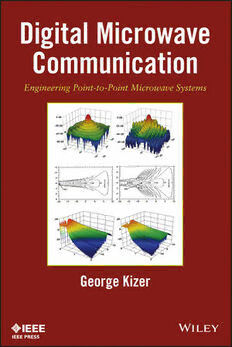Table Of ContentDIGITAL MICROWAVE
COMMUNICATION
IEEE Press
445 Hoes Lane
Piscataway, NJ 08854
IEEE Press Editorial Board 2013
John Anderson, Editor in Chief
Linda Shafer Saeid Nahavandi George Zobrist
George W. Arnold David Jacobson Tariq Samad
Ekram Hossain Mary Lanzerotti Dmitry Goldgof
Om P. Malik
Kenneth Moore, Director of IEEE Book and Information Services (BIS)
DIGITAL MICROWAVE
COMMUNICATION
Engineering Point-to-Point
Microwave Systems
GEORGE KIZER
Copyright©2013byTheInstituteofElectricalandElectronicsEngineers,Inc.
PublishedbyJohnWiley&Sons,Inc.,Hoboken,NewJersey.Allrightsreserved
PublishedsimultaneouslyinCanada
Nopartofthispublicationmaybereproduced,storedinaretrievalsystem,ortransmittedinanyformorbyany
means,electronic,mechanical,photocopying,recording,scanning,orotherwise,exceptaspermittedunder
Section107or108ofthe1976UnitedStatesCopyrightAct,withouteitherthepriorwrittenpermissionofthe
Publisher,orauthorizationthroughpaymentoftheappropriateper-copyfeetotheCopyrightClearanceCenter,
Inc.,222RosewoodDrive,Danvers,MA01923,(978)750-8400,fax(978)750-4470,oronthewebat
www.copyright.com.RequeststothePublisherforpermissionshouldbeaddressedtothePermissions
Department,JohnWiley&Sons,Inc.,111RiverStreet,Hoboken,NJ07030,(201)748-6011,fax(201)
748-6008,oronlineathttp://www.wiley.com/go/permission.
LimitofLiability/DisclaimerofWarranty:Whilethepublisherandauthorhaveusedtheirbesteffortsin
preparingthisbook,theymakenorepresentationsorwarrantieswithrespecttotheaccuracyorcompletenessof
thecontentsofthisbookandspecificallydisclaimanyimpliedwarrantiesofmerchantabilityorfitnessfora
particularpurpose.Nowarrantymaybecreatedorextendedbysalesrepresentativesorwrittensalesmaterials.
Theadviceandstrategiescontainedhereinmaynotbesuitableforyoursituation.Youshouldconsultwitha
professionalwhereappropriate.Neitherthepublishernorauthorshallbeliableforanylossofprofitoranyother
commercialdamages,includingbutnotlimitedtospecial,incidental,consequential,orotherdamages.
Forgeneralinformationonourotherproductsandservicesorfortechnicalsupport,pleasecontactourCustomer
CareDepartmentwithintheUnitedStatesat(800)762-2974,outsidetheUnitedStatesat(317)572-3993orfax
(317)572-4002.
Wileyalsopublishesitsbooksinavarietyofelectronicformats.Somecontentthatappearsinprintmaynotbe
availableinelectronicformats.FormoreinformationaboutWileyproducts,visitourwebsiteatwww.wiley.com.
LibraryofCongressCataloging-in-PublicationData:
Kizer,GeorgeM.(GeorgeMaurice),1945-
Digitalmicrowavecommunication:engineeringpoint-to-pointmicrowave
systems/GeorgeKizer.
pagescm
ISBN978-0-470-12534-2(hardback)
1.Microwavecommunicationsystems.2.Digitalcommunication.I.Title.
TK7876.K5482013
621.382–dc23
2012048284
PrintedintheUnitedStatesofAmerica
ISBN:9780470125342
10987654321
CONTENTS
Preface xv
Acknowledgments xvii
AbouttheAuthor xix
1 ABriefHistoryofMicrowave RadioFixedPoint-to-Point(Relay)
CommunicationSystems 1
1.1 IntheBeginning, 1
1.2 MicrowaveTelecommunications Companies, 7
1.3 PracticalApplications, 10
1.4 TheBeatGoesOn, 14
References, 16
2 RegulationofMicrowave RadioTransmissions 20
2.1 RadioFrequencyManagement, 21
2.2 TestingforInterference, 28
2.3 RadioPathsbyFCCFrequencyBandintheUnitedStates, 29
2.4 InfluencesinFrequency AllocationandUtilizationPolicywithinthe
WesternHemisphere, 30
2.4.1 UnitedStatesofAmerica(USA), 30
2.4.2 Canada, 36
2.5 FCCFixedRadioServices, 36
2.6 SiteDataAccuracy Requirements, 41
2.7 FCCAntennaRegistrationSystem(ASR)RegistrationRequirements, 42
2.8 EngineeringMicrowavePathsNearAirportsandHeliports, 44
2.8.1 AirportGuidelines, 46
References, 47
3 Microwave RadioOverview 48
3.1 Introduction, 48
3.2 DigitalSignaling, 50
3.3 NoiseFigure,NoiseFactor,NoiseTemperature, andFrontEndNoise, 50
v
vi CONTENTS
3.4 DigitalPulseAmplitudeModulation(PAM), 53
3.5 RadioTransmittersandReceivers, 58
3.6 ModulationFormat, 60
3.7 QAM DigitalRadios, 65
3.8 ChannelEqualization, 68
3.9 ChannelCoding, 70
3.10 TrellisCodedModulation(TCM), 72
3.11 OrthogonalFrequency DivisionMultiplexing(OFDM), 75
3.12 RadioConfigurations, 76
3.12.1 Cross-PolarizationInterferenceCancellation(XPIC), 78
3.13 Frequency DiversityandMultilineConsiderations, 82
3.14 TransmissionLatency, 85
3.15 Automatic TransmitterPowerControl(ATPC), 87
3.16 CurrentTrends, 87
3.16.1 TDM(orATM)overIP, 87
3.16.2 TDMSynchronization overIP, 88
3.16.3 AdaptiveModulation, 89
3.16.4 QualityofService(QoS)[GradeofService(GoS)inEurope], 89
References, 90
4 RadioNetworkPerformanceObjectives 96
4.1 CustomerServiceObjectives, 96
4.2 Maintenance Objectives, 96
4.3 CommissioningObjectives, 98
4.4 DesignObjectives, 98
4.4.1 Quality, 98
4.4.2 Availability, 98
4.5 Differences BetweenNorthAmerican andEuropeanRadioSystemObjectives, 99
4.5.1 NorthAmericanRadioEngineeringStandards(Historical
BellSystemOriented), 99
4.5.2 EuropeanRadioEngineeringStandards (ITUOriented), 99
4.6 NorthAmericanTelecommunications SystemDesignObjectives, 100
4.7 InternationalTelecommunications SystemDesignObjectives, 100
4.7.1 LegacyEuropeanMicrowaveRadioStandards, 102
4.7.2 ModernEuropeanMicrowaveRadioStandards, 102
4.8 EngineeringMicrowavePathstoDesignObjectives, 102
4.9 Accuracy ofPathAvailability Calculations, 106
4.9.1 RainFading, 106
4.9.2 MultipathFading, 106
4.9.3 DispersiveFadingOutage, 107
4.9.4 DiversityImprovementFactor, 107
4.10 ImpactofFlatMultipathVariability, 108
4.11 ImpactofOutageMeasurementMethodology, 108
4.12 ImpactofExternalInterference, 109
4.13 Conclusion, 109
References, 110
5 RadioSystemComponents 114
5.1 MicrowaveSignalTransmissionLines, 115
5.2 Antenna SupportStructures, 121
5.2.1 LatticeTowers, 122
5.2.2 Self-SupportingTowers, 122
5.2.3 GuyedTowers, 122
CONTENTS vii
5.2.4 Monopoles, 124
5.2.5 ArchitecturallyDesignedTowers, 125
5.2.6 Building-MountedAntennas, 126
5.2.7 CamouflagedStructures, 126
5.2.8 TemporaryStructures, 126
5.3 TowerRigidityandIntegrity, 127
5.4 TransmissionLineManagement, 127
5.5 Antennas, 127
5.6 NearField, 137
5.7 FundamentalAntennaLimitations, 143
5.8 Propagation, 143
5.9 RadioSystemPerformanceasaFunctionofRadioPathPropagation, 145
5.9.1 FlatFading, 146
5.9.2 DispersiveFading, 148
5.10 RadioSystemPerformanceasaFunctionofRadioPathTerrain, 149
5.11 AntennaPlacement, 153
5.12 FrequencyBandCharacteristics, 155
5.13 PathDistances, 157
5.A Appendix, 159
5.A.1 AntennaIsotropicGainandFreeSpaceLoss, 159
5.A.2 FreeSpaceLoss, 163
5.A.3 AntennaIsotropicGain, 164
5.A.4 Circular(Parabolic)Antennas, 166
5.A.5 Square(Panel)Antennas, 167
5.A.6 11-GHzTwo-footAntennas, 168
5.A.7 TowerRigidityRequirements, 169
References, 172
6 DesigningandOperatingMicrowave Systems 175
6.1 WhyMicrowaveRadio? 175
6.2 RadioSystemDesign, 175
6.3 DesigningLowFrequency RadioNetworks, 179
6.4 DesigningHighFrequencyRadioNetworks, 182
6.4.1 HubandSpoke, 183
6.4.2 NestedRings, 184
6.5 FieldMeasurements, 185
6.6 UserDataInterfaces, 185
6.7 OperationsandMaintenance, 202
6.7.1 FaultManagement, 203
6.7.2 AlarmsandStatus, 206
6.7.3 PerformanceManagement, 207
6.8 MaintainingtheNetwork, 210
References, 217
7 HypotheticalReference Circuits 220
7.1 NorthAmerican(NA)Availability Objectives, 220
7.1.1 NABellSystemHypothetical ReferenceCircuit-AvailabilityObjectives, 220
7.1.2 NATelcordiaHypothetical ReferenceCircuit-AvailabilityObjectives, 222
7.2 NorthAmericanQualityObjectives, 225
7.2.1 ResidualBER, 225
7.2.2 BurstErroredSeconds, 225
7.2.3 DS1ErroredSeconds, 225
7.2.4 DS3ErroredSeconds, 225
viii CONTENTS
7.3 InternationalObjectives, 225
7.3.1 InternationalTelecommunication UnionAvailabilityObjectives, 228
7.4 InternationalTelecommunication UnionQualityObjectives, 236
7.4.1 LegacyQualityObjectives, 236
7.4.2 CurrentQualityObjectives, 240
7.5 Error-PerformanceRelationshipAmongBER,BBER,andSESs, 245
References, 247
8 Microwave AntennaTheory 249
8.1 CommonParameters, 251
8.2 PassiveReflectors, 252
8.2.1 PassiveReflectorFarFieldRadiationPattern, 253
8.2.2 PassiveReflectorNearFieldPowerDensity, 255
8.3 Circular(Parabolic)Antennas, 256
8.3.1 Circular(Parabolic)AntennaFarFieldRadiationPattern, 256
8.3.2 Circular(Parabolic)AntennaEfficiency, 260
8.3.3 Circular(Parabolic)AntennaBeamwidth, 261
8.3.4 Circular(Parabolic)AntennaNearFieldPowerDensity, 264
8.3.5 GeneralNearFieldPowerDensityCalculations, 265
8.3.6 CircularAntenna NearFieldPowerDensityTransitions, 272
8.3.7 CircularAntenna FarFieldReferencePower, 273
8.4 SquareFlatPanelAntennas, 274
8.4.1 SquareAntenna Beamwidth, 276
8.4.2 SquareNearFieldPowerDensity, 279
8.4.3 SquareAntenna FarFieldReferencePower, 288
8.4.4 SquareNearFieldPowerDensityTransitions, 289
8.5 RegulatoryNearFieldPowerDensityLimits, 290
8.6 PracticalNearFieldPowerCalculations, 290
8.6.1 AParabolicAntennaNearFieldPowerExampleCalculation, 293
8.6.2 SafetyLimits, 294
8.7 NearFieldAntenna CouplingLoss, 296
8.7.1 AntennatoAntenna NearFieldCouplingLoss, 296
8.7.2 CouplingLossbetweenIdenticalAntennas, 300
8.7.3 CouplingLossbetweenDifferent-SizedCircularAntennas, 300
8.7.4 CouplingLossbetweenDifferent-SizedSquareAntennas, 301
8.7.5 ParabolicAntennatoPassiveReflectorNearFieldCouplingLoss, 302
8.7.6 CouplingLossforCircularAntenna andSquareReflector, 303
8.7.7 CouplingLossforSquareAntennaandSquareReflector
(BothAligned), 305
8.7.8 Back-to-BackSquarePassiveReflectorNearFieldCouplingLoss, 306
8.A Appendix, 307
8.A.1 CircularAntenna NumericalPowerCalculations, 307
8.A.2 SquareAntenna NumericalPowerCalculations, 311
8.A.3 BesselFunctions, 315
References, 318
9 MultipathFading 320
9.1 FlatandDispersiveFading, 329
9.A Appendix, 338
9.A.1 FadingStatistics, 338
9.A.2 DFMEquationDerivation, 339
9.A.3 CharacteristicsofReceiverSignatureCurvesandDFM, 342
References, 344
CONTENTS ix
10 Microwave RadioDiversity 348
10.1 SpaceDiversity, 350
10.2 Dual-FrequencyDiversity, 354
10.3 Quad(SpaceandFrequency)Diversity, 357
10.4 HybridDiversity, 358
10.5 MultilineFrequencyDiversity, 358
10.6 CrossbandMultiline, 365
10.7 AngleDiversity, 366
10.7.1 AngleDiversityConfigurations, 368
10.7.2 AngleDiversityPerformance, 371
10.A Appendix, 372
10.A.1 OptimizingSpaceDiversityVertical Spacing, 372
10.A.2 AdditionalOptimization, 377
References, 380
11 RainFading 384
11.1 Point(Single-Location)RainLoss(Fade)Estimation, 386
11.2 PathRain-FadeEstimation, 390
11.3 Point-to-PathLengthConversionFactor, 398
11.4 Single-LocationRainRateR, 398
11.5 CityRainRateDataforNorthAmerica, 407
11.6 NewRainZones, 430
11.7 Worst-MonthRainRates, 430
11.8 PointRainRateVariability, 439
11.9 ExamplesofRain-Loss-DominatedPathDesigns, 441
11.10 Conclusions, 444
11.A Appendix, 446
11.A.1 NorthAmericanCityRainDataIndex, 446
References, 458
12 DuctingandObstructionFading 461
12.1 Introduction, 461
12.1.1 PowerFading, 463
12.2 Superrefraction(Ducting), 465
12.3 Subrefraction(EarthBulgeorObstruction), 469
12.4 MinimizingObstructionFading, 471
12.4.1 PathClearance(Antenna VerticalPlacement)Criteria, 471
12.5 ObstructionFadingModel, 477
12.6 ObstructionFadingEstimation, 479
12.7 BellLabsSeasonalParameterCharts, 483
12.8 RefractivityDataLimitations, 484
12.9 ReviewingtheBellLabsSeasonalParameterCharts, 485
12.10 ObstructionFadingParameterEstimation, 486
12.11 EvaluatingPathClearanceCriteria, 487
12.A Appendix:NorthAmericanRefractivityIndexCharts, 490
12.B Appendix:WorldwideObstructionFadingData, 491
References, 511
13 ReflectionsandObstructions 514
13.1 TheoreticalRoughEarthReflectionCoefficient, 514
13.1.1 GaussianModel, 516
13.1.2 UniformModel, 517
x CONTENTS
13.2 ScatteringfromEarthTerrain, 517
13.3 PracticalEarthReflectionCoefficient, 519
13.4 ReflectionLocation, 519
13.5 SmoothEarthDivergence Factor, 522
13.6 Reflections fromObjects NearaPath, 523
13.7 FresnelZones, 525
13.8 Antenna LaunchAngle(TransmitorReceiveAntennaTakeoffAngle), 527
13.9 GrazingAngle, 527
13.10 AdditionalPathDistance, 528
13.11 EstimatingtheEffectofaSignalReflectedfromtheEarth, 528
13.12 FlatEarthObstructionPathLoss, 529
13.13 SmoothEarthObstructionLoss, 529
13.14 Knife-EdgeObstructionPathGain, 530
13.15 Rounded-EdgeObstructionPathGain, 531
13.16 ComplexTerrainObstructionLosses, 532
13.A Appendix, 536
13.A.1 SmoothEarthReflectionCoefficient, 536
13.A.2 ProcedureforCalculating R ANDR , 536
H V
13.A.3 EarthParametersforFrequencies Between100kHzand1GHz, 538
13.A.4 EarthParametersforFrequencies Between1GHzand100GHz, 540
13.A.5 CommentsonConductivityandPermittivity, 541
13.A.6 ReflectionCoefficients, 541
References, 555
14 DigitalReceiver Interference 559
14.1 CompositeInterference((cid:2)T/T)Criterion, 559
14.2 Carrier-to-InterferenceRatio(C/I)Criterion, 560
14.3 MeasuringC/I, 560
14.4 EstimatingC/I, 561
14.5 ThresholdtoInterference(T/I)Criterion, 562
14.6 WhyEstimateT/I, 563
14.7 T/IEstimation—MethodOne, 564
14.8 T/IEstimation—MethodTwo, 565
14.9 Conclusion, 569
14.A Appendix, 569
14.A.1 Basic10−6 ThresholdforGaussian(RadioFrontEnd)NoiseOnly, 569
14.A.2 UsingaSpectrumMaskasaDefaultSpectrumCurve, 570
14.B Appendix: ReceiverParameters, 571
References, 572
15 NetworkReliabilityCalculations 573
15.1 Hardware Reliability, 574
15.2 SystemReliability, 577
15.2.1 EquipmentinSeries, 577
15.2.2 MultipleEquipmentinParallel, 578
15.2.3 NestedEquipment, 579
15.2.4 MeshedDuplexConfiguration, 579
15.3 CommunicationSystems, 579
15.4 Application toRadioConfigurations, 580
15.5 SpareUnitRequirements, 580
15.6 BEREstimation, 583
15.6.1 TimetoTransmitNDigits, 585
References, 585

